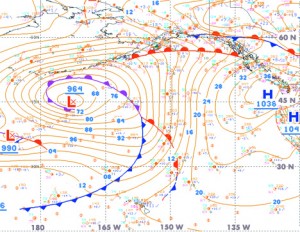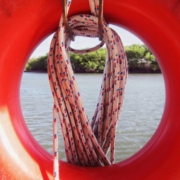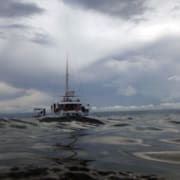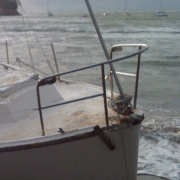Where is the storm center?
We’ve received a few questions on clarification of the mechanics of determining the direction of the center of a weather system either a high or a low. So we added it to Module 4 of the weather course and we’re also describing it here.
The graphic below shows a weather map in the northern pacific last week. You can see two systems, a giant low system at 173 degrees west and 45 degrees north and a giant high system to the east at 127 degrees west and 47 degrees north. You’ll also notice the large cold front heading east and a warm front heading north. If your vessel was located at 150 degrees west and 45 degrees north, you’ll notice that the wind will be directly out of the south. This direction is created from the rotation of both systems in the opposite direction. Thus if you face the wind, the low will be on your right and the high will be on your left. This is a general rule that you can use in the northern hemisphere. In the southern hemisphere it is opposite – with your face to the wind the low will be on your right and the high will be on your left. It’s always best to simply draw the circles in your mind or on paper. Then draw the direction of rotation. Then place yourself anywhere on the circle with your face to the wind. Extend your arms and viola!
Here then is an example of application of the rule of “put the wind on your starboard side in the northern hemisphere”. If your vessel was at 172 degrees west and 40 degrees north with the wind on your starboard side, you’d be heading away from the storm system (south), and towards Hawaii which wouldn’t be bad anyway.







